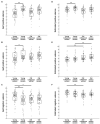Age and parous-experience dependent changes in emotional contagion for positive infant sounds
- PMID: 38601818
- PMCID: PMC11004475
- DOI: 10.3389/fpsyg.2024.1336126
Age and parous-experience dependent changes in emotional contagion for positive infant sounds
Abstract
Introduction: Emotional contagion is achieved by inferring and emotionally resonating with other persons' feelings. It is unclear whether age-related changes in emotional contagion for infant sounds are modulated by the experience of childbirth or childcare. This study aims to evaluate changes in inference and emotional resonance for positive and negative infant sounds (laughter and crying) among women, based on age and parous experience.
Methods: A total of 241 women (60 young nulliparous, 60 young parous, 60 old nulliparous, and 61 old parous) completed a web-based questionnaire. After listening to three types of infant sounds (laughter, cooing, and crying), participants responded with their valence for hearing infant sounds and estimated infant valence on an 11-point Likert scale.
Results: The analysis for emotional resonance revealed that the correlation coefficient between self and estimated infant valences was greater in young parous and old nulliparous women than in young nulliparous women, in laughter and cooing sounds. However, correlation coefficients for crying did not differ among any of the four groups.
Conclusion: The degree of emotional resonance for infant valence increased depending on age and parous-experience for positive infant sounds.
Keywords: emotion; empathy; valence; voice; well-being; women.
Copyright © 2024 Mizuguchi, Kato, Sugawara, Yoshimi, Goto, Takasu and Isaka.
Conflict of interest statement
This work was a part of collaborative research (kando project) with Yamaha Motor Co., Ltd. However, the company was not involved in the writing of this article nor the decision to submit it for publication. The remaining authors declare that the research was conducted in the absence of any commercial or financial relationships that could be construed as a potential conflict of interest.
Figures




Similar articles
-
Investigating emotional contagion in dogs (Canis familiaris) to emotional sounds of humans and conspecifics.Anim Cogn. 2017 Jul;20(4):703-715. doi: 10.1007/s10071-017-1092-8. Epub 2017 Apr 21. Anim Cogn. 2017. PMID: 28432495 Free PMC article.
-
Contagious Crying Revisited: A Cross-Cultural Investigation Into Infant Emotion Contagion Using Infrared Thermal Imaging.Dev Sci. 2025 Mar;28(2):e13608. doi: 10.1111/desc.13608. Dev Sci. 2025. PMID: 39810330 Free PMC article.
-
Emotional contagion: dogs and humans show a similar physiological response to human infant crying.Behav Processes. 2014 Oct;108:155-65. doi: 10.1016/j.beproc.2014.10.006. Epub 2014 Nov 4. Behav Processes. 2014. PMID: 25452080
-
Individual differences in infants' neural responses to their peers' cry and laughter.Biol Psychol. 2018 May;135:117-127. doi: 10.1016/j.biopsycho.2018.03.008. Epub 2018 Mar 27. Biol Psychol. 2018. PMID: 29596956
-
Effects of emotionally charged sounds in schizophrenia patients using exploratory eye movements: comparison with healthy subjects.Psychiatry Clin Neurosci. 2010 Feb;64(1):10-8. doi: 10.1111/j.1440-1819.2009.02043.x. Psychiatry Clin Neurosci. 2010. PMID: 20416023
References
LinkOut - more resources
Full Text Sources

